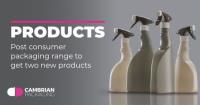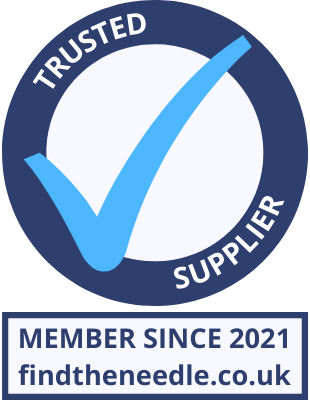 Add My Company
Add My Company
Sign In

Our ZER0 range of post consumer packaging will soon include a trigger sprayer made from at least 35% recycled content, and a 500ml cylindrical bottle.
The shroud (top cover) and the trigger lever of the new plastic trigger spray head (product code MV2WWSO255-30) are made from 100% Post-Consumer Recycled (PCR) material. This results in the finished product being 35% PCR by weight
Adair Simpson, Commercial Director at Cambrian Packaging, said: “This is great news for brands who want to offer the full recycled packaging solution, because it can be paired with our ZER0 or Ecycle™ bottle ranges.
“In addition to the environmental benefits, the trigger head is also exempt from the Plastic Packaging Tax!”
The trigger sprayer’s all-plastic construction means there are no metal parts, and it can be completely recycled again. It has wide chemical compatibility and its pre-compression action gives excellent atomising performance.
What is post consumer packaging?
Post-consumer packaging, or Post-Consumer Recycled (PCR) packaging, is packaging made from materials that the public have used and recycled. This can include plastics, paper or cardboard for example. The recycled materials are formed into pellets or recycled feedstock, which can then be moulded into plastic resin or other items.
When it comes to PCR PET bottles and PCR HDPE bottles, the most common PCR plastics used come from PET and HDPE items such as milk bottles and clear drinks bottles. These types of plastic are also really easy to recycle. Recycled PET and HDPE is referred to as rPET and rHDPE.
By recycling these items for further use, we can avoid them going into landfill, which is why Cambrian strives to raise consumer awareness of what kinds of plastic can and can’t be widely recycled. You can find out more information in our knowledge section here, under ‘An Overview of Recycling’. By saving these plastics for re-use, consumers can help to boost the availability of recyclate.
Why are more brands switching to post consumer packaging?
Post consumer packaging (PCR packaging) has been growing in popularity among brands who want to put across a sustainable message under increasing consumer pressure – but a change in UK law has meant that even more companies are now considering making the switch.
As you might be aware, the Plastic Packaging Tax came into effect as of April 1, April 2022. The intention of the tax is to provide an economic incentive encouraging the use of packaging which includes recycled material. It applies to plastic packaging items produced in (or imported into) the UK that do not contain at least 30% recycled plastic.
Is post consumer packaging more expensive than virgin plastic?
Recycled polymer used in post consumer packaging is more costly than standard virgin polymer due to the processes involved in its manufacture, so packaging made using this material usually carries a higher cost. However, the Plastic Packaging Tax applies to standard packaging containing no recycled material, so this will influence any cost difference.
The anticipated increase in demand for PCR polymer is expected to have an impact on the longer-term cost and availability of this material for post consumer packaging. This is another reason why more investment is needed to boost recycling rates and therefore the amount of recyclate available.
Is post consumer packaging environmentally friendly?
It takes 75% less energy to make a plastic bottle from recycled plastic compared with using ‘virgin’ materials, according to WRAP’s UK Plastics Pack Annual Report (2020/21). Post consumer packaging can help to reduce a company’s carbon footprint, getting it several steps closer to becoming carbon neutral, which is top of the agenda for many businesses.
Recycling depends largely on the infrastructure present to recycle materials and the consumer approach to recycling. The more materials that are recycled, the more recyclate will be available to make other items, such as PCR packaging. As with any packaging, if post consumer packaging is not recycled correctly, it can end up in landfill, so it is important that recycling instructions are shown on labels.
Mr Simpson added: “We know that sustainability and recycled content is extremely important to today’s consumers. Even attitudes to the colour of recycled plastic bottles have changed. The distinctive green/grey colour of this trigger sprayer shows consumers that these parts are manufactured in 100% recycled material.”
What is Cambrian doing to expand its range of Post-Consumer Recycled (PCR) packaging?
As you may know, we’ve been offering customers our Ecycle™ range made from 100% recycled HDPE (rHDPE) since 2017, and we were one of the first plastic packaging suppliers to offer post consumer packaging.
We realise that a 100% recycled option is not the best fit for all brands. With the Plastic Packaging Tax on the horizon, last summer we launched a new range of packaging with at least 30% recycled content – our ZER0 range.
Since then, we have expanded the range to include 23 products, with more additions being made on a regular basis. The latest additions to the range include the AL750FC/28-30 and CA500FC-30, two PCR PET bottles, which we have swapped to 30% PCR from virgin. Where possible, we are continuing to swap firm favourites with at least 30% PCR content.
One of the most popular products in our ZER0 range is the 30% recycled Elan spray bottle, which was the first spray bottle to be added to this range. It is available in 500ml and 750ml in white, made from 30% post-consumer recycled HDPE polymer and 70% standard HDPE.
For more information on Post consumer packaging range to get two new products talk to Cambrian Packaging
Enquire Now
List your company on FindTheNeedle.

